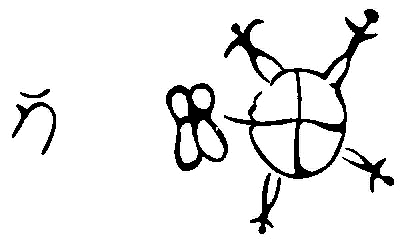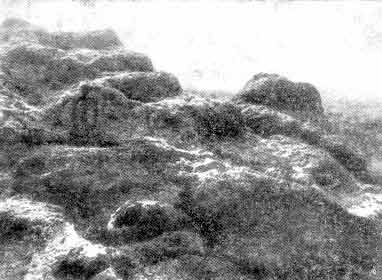ON ANCIENT ASTRONOMY IN ARMENIA
Byurakan Astrophysical
Observatory,
Armenia
Armenia

The Armenian highland is one of the ancient cradles
of civilisation. Many investigators of the history of astronomy , having
no facts to hand, mainly by logical approach came to the conclusion that
the ancient inhabitants of Armenia not only knew, but also took part in
the formation of ancient astronomy (Maunder, 1906, Olcott, 1914) .
Thus Olcott (1914) wrote: "Astronomical
facts correspond with historical and archaeological investigations and
prove that people who have invented the ancient figures of constellations
probably lived in the valley of the Euphrates , as well as in the region
near the mountain Ararat"
Maunder (1906), investigating the question
of the origin of the constellations, wrote:
"People, who divided the sky into constellations,
most probably lived between 36 and 42 degrees of the northern latitude,
so neither Egypt nor Babylon could be the motherland of creation of constellations.
Calculating in what place the centre of this empty region coincides with
the North Pole, we got the figure 2800 BC, which is probably the date
during which the naming of the constellations were completed. It was observed
that such animals as the elephant, camel, hippopotamus, crocodile and
tiger were not amongst the figures representing the constellations, therefore
we, can assert India, Arabia and Egypt could not have been the place where
the idea of firmament originated.
We can exclude Greece, Italy and
Spain on the basis of the fact that the figure of tiger is present in
the figures of constellations
Thus purely by logical thinking we
can assert that the motherland of celestial figures must be Minor Asia
and Armenia, that is to say a region limited by the Black, the Mediterranean,
the Caspian and the Aegean Seas..."
The above statements had to
be confirmed
The discoveries made during
the last decades in Armenia. have enriched our knowledge of the ancient
civilisation and ancient astronomy in this region
On Armenian territory , a belt
calendar and geocentric model of the universe were discovered from the
Bronze Era, dating back to the XI century BC (rumanian, Mnazakanian, 1965)
Furthermore, rock carvings of astro- nomical representations of the Sagittarius,
lion and Scorpio constellations, along with symbols of the Sun and the
Moon, were discovered on fragments

Figure 1 Image of Earth with the antipodes foand on rocks
of rocks older than 3000
years. The diameters of the pictures are different from each other. indicating
the relative brightness of the stars. On one fragment the Sun, Moon. and
five planets. as seen with the naked eye are pictured, and on another
two fragments there are circles with short and 29 long rays. The rays
carved on the rocks probably depict the period of repetition of the Lunar
phases.
A carved circle found on one of the
rocks created a great deal of interest. This circle is divided into orthogonal
lines, in which (on opposing sides) are also carved human figures.. These
symbols represent the Earth and antipodes
(Figure1). Such symbolism is used in modern
astronomy Tumanian, Petrosian, 1970)
THE ANCIENT "OBSERVATORY" OF MEZAMOR
The important discovery, which enriched our knowledge of ancient astronomy
in Armenia, /were the complex of platforms for astronomical observations
on the Small Hill of Mezamor, which may be called an ancient "observatory".
Investigations on that Hill show that the ancient inhabitants of the Armenian
Highlands have left us not only pictures of celestial bodies. but a very
ancient complex of platforms for observing the sky.
On the bank of the river Mezamor, some
30km West of Yerevan, a metal-producing centre was found, dating back
to the third millennium BC .The life here dated from V millennium BC till
to XVIII century AD.

Figure 2. The first platform with stellar symbols on the east side.
Here on the Small Hill of Mezamor in 1966 the platforms for astronomical
observations were discovered, which form a peculiar complex -an ancient
"observatory" ( Parsamian and Mkrtchian, 1969, Parsamian , 1985, 1988).
Of the platforms, three are particularly well
preserved.
The first is triangular in shape, with its smallest
angle facing the South. The bisector of that angle coincides with the
North-South direction ( to an accuracy 2 degrees). On the rock surfaces
a number of symbols are carved. These symbols and images are sometimes
also repeated on the other rocks as well.
On the east side of the first platform
there are four identical stellar symbols surrounded by a trapezium measuring
55x40 cm. Of these four symbols, three are particularly well preserved.
This trapezium is drawn narrower in the south-east; a choice of geometry
which is not accidental, as will be revealed later..
One might assume that the centre of the
platform might be a good place to place the symbols. However. the positioning
of the trapezium and the symbols may be the key to its secrets. The fact
that the trapezium with the star symbols is carved on the eastern side
suggests the idea that it is connected with the rising of some star or
the Sun. The Sun however can be excluded .as it used to have its own unique
symbol in ancient times. The question now is which heavenly body was the
trapezium pointing to?
Let's continue mentally the altitude of
the trapezium till the horizon and see, with the rising of what heavenly
bodies this direction is connected. We measured the azimuth of the trapezium
with a compass and made some calculations. Let A- be the azimuth of the
carved altitude of the trapezium dividing it into two equal parts {the
line of the altitude is preserved but it is drawn roughly, so an error
of measurements of the azimuth of the trapezium gave the value A = 298°,
The value of declination was found to be -21°, the value of hour angle
t-71° . From these data it is not difficult to establish what bright stars
had the above mentioned declination and when. According to 5000 year star
catalogue (Hawkins and Rosental, 1967) table 1 gives the name of four
brightest stars, their brightness, as well as the epochs when declination
was equal to -21° there are four candidates: Sirius, Rigel, Antares, B
C.Ma.Most probably Sirius was observed and worshipped by the ancient inhabitants
of Mezamor and the information they left is about this star.
Table 2 below
gives the results of calculations for the rising of Sirius in Mezamor
at summer Solstice; we indicate the epoch for three different values of
azimuth (A = 298° being the most probable value) .
The table 2 shows
how strongly the epoch changes with a change in declination of two degrees.
TABLE 1
|
STAR |
MAGNITUDE |
EPOCH |
||
| Sirius |
-1.58
|
-2.600
|
||
|
Rigel |
0.34 |
-2.100 |
||
|
Antares |
1.22 |
400 |
||
|
B C.Ma |
1.99 |
-1000 |
||
TABLE 2
|
AZIMUTH(0) |
DECLINATION (0) |
LOCAL TIME |
EPOCH |
|||
| 300 |
-22.20
|
4h39m
|
-2800
|
|||
|
298 |
-22.55 |
4h 43m |
-2600 |
|||
|
296 |
-19.00 |
5h 03m |
-1900 |
|||
It was shown that in the years between 2800-2600 BC Sirius could have been observed at Solstice in the morning, in the rays of the rising Sun, this being the so-called helical rising of Sirius. It is obvious from the data that Sirius, the brightest star in our hemisphere could have been the object of worship by the inhabitants of Mezamor. It is possible that, like the ancient Egyptians, the inhabitants of Mezamor related the first appearance of Sirius with the opening of the year.

Figure 3. The third platform with seven steps.
The occurrence of the symbol
for Sirius four times in the trapezium can be explained by the fact that
as in the Egyptian calendar, where the year had 365 days, after each 4
years the rising of Sirius was shifted from the first day to the second
day of the month, and after another 4 years from the 3rd day to the 4th
and so on. If these suppositions are correct, then the findings on the
first platform prove that the inhabitants of Armenia were well acquainted
with the sky, and could have used the periodical appearance for measuring
time.
The second
platform is situated 2.5m above the first one. It is also triangular and
in the plane of meridian. The sign of the Sun and other signs are there.
Of special
interest is the third platform. It differs from the other two in having
seven steps carved in the rock, which lead in from a North-South direction.
These steps are positioned roughly in the plane of the meridian. If the
stairs leading to the platform were in the East-West direction, then one
might assume that the platform was being used for religious ceremonies.
The stairs however were positioned in the North-South direction, which
provided an optimum position for carrying out astronomical observations.
On the last step leading to the platform, a carved directional indicator
(compass) was made which shows North-South-East directions. The presence
of the compass suggests that the platform was not positioned exactly on
the meridian plane and this compass had to be use to correct the position
of the observer. The other carved signs found on the hills and the platforms
also lead us to understand that the platforms, as well as serving as astronomical
observation platforms, could also be used for religious rituals.
But for
religious rituals on the Main Hill of Mezamor was found Pagan Altar situated
in the plane east-west from the first millennium BC
MEGALITHIC MONUMENT ZORAZ KAR
Among the ancient monuments in Armenia there is a megalithic monument, probably, being connected with astronomy. 250km south-east of Yerevan there is a structure Zoraz Kar dating back to II millennium BC. Vertical megaliths many of which are more than two meters of height form stone rings resembling to ancient stone monuments -henges in Great Britain and Brittany (Parsamian,1985,Khunkikian, 1985, Parsamian and Barsegian, 1987, Geruni, 1999)
.
Figure 4 A carvea directional indicator (compass) is on the top of the third platform. It indicates north-south-east directions
The diameter of the main stone ring of Zoraz Kar is more than 30m and
it is notable that on some stones found in the eastern part there are
well polished round holes, which could have been used for the observation
of the Sun in the days of equinox and solstice. The main ring is connected
with megaliths in S-E direction by gate of two megaliths the distance
between which more than between other stones. The first observations of
the sunrise the days of solstice shows that the middle line of gate has
direction East-West. On the direction N-E from the gate there is a range
of nine megaliths. Sunrise observations on June 22, 1985 shows that at
the moment of sunrise Sun appearance on the top of highest megalith from
the gate. In the same moment it was possible to see Sun in the holes of
two megaliths N 39 and N 44. Numeration was begin from north end of stone
avenue which lead to main stone ring in the N-S direction. After short
time during sunrise Sun was seen trough first megaliths hole from the
gate.
During the observations of sunrise on 21 September.
1985 before appearance of Sun in the middle of gate we observed Venus.
We suggested that the place of gate was chosen for
observations of periodic events (Parsamian, 1985, Parsamian and Barsegian,
1987).
In the same region about 40 km from Zoraz Kar
there is a village the name of Karahunge which give us some information
to meditate.
Figure 5. Zoraz Kar.
Karahunge is a complicate word : "Kara"-
means stone, "hunge" may be means bouquet, in Armenian dictionary there
is not that word (Parsamian, 1985).
According to hypothesis of Gamkrelidze and Ivanov (1990) Indo-European
languages were originated on the eastern Anatolia which is historical
homeland of Armenians.
MEDIEVAL OBSERVATIONS OF COMETS AND NOVAE BY
DATA IN ANCIENT ARMENIAN MANUSCRIPTS

Figure 6 The Sunrise Observation in the summer solstice, 1985
In the collection
of ancient Armenian manuscripts (Matenadaran)
In Yerevan .there are many manuscripts
with information about observations of astronomical events as: solar and
lunar eclipses, comets and novae, bolids and meteorites etc. in medieval
Armenia.
In particularly there are interesting information
about observations of supernovae in 1006 , 1054, possible supernova in
716, two novae in 762 , (Astapovich, 1974 , Tumanian, 1964, 1967, Barseghian,
Parsamian, 1990 ).
Till to now 75 information about appearances
of 60 comets are found in Armenian medieval sources (Vsekhsvjatskij and
Tumanian, 1970, Tumananian, 1968, Barsegian and Epremian, 1989). In particularly
Halley's comet were observed from Armenia In 684, 989, 1066, 1222, 1145
and 1531 ( Brutian, 1988, Barseghian, Epremian, 1989, Barseghian, Parsamian,
1998 ).
REFERENCES
IS. ASTAPOVICH, Astron. Zirk. ANSSSR, 826, 1974.
A. J. BARSEGHIAN ond R. A. EPREMIAN, Soobsch. Byurakan Obs., 61: 1989.
A. J. BARSEGUIAN and E. S PARSAMIAN, Soabsch. Byurakon Obs., 63,92,1990. A. J. BARSEGUIAN, E. S. PARSAMIAN. Proceed. af Armpedinst.. 49, 1998. G. H. BRUTIAN, 199B, private communicotian
A. J. BARSEGUIAN and E. S. PARSAMIAN, 1998, private communication. T. v: GAMKREllDZE and v: Vs. IVANOV V. Mire Nauki, 5, 66. 1990. f! GERUNI, Dokl. NAN of Armenia, v.98, 307, 1998.
E. MAUNDER, Astronomy without Telescopes, London, 1906. w. OLCOTT. Legends of Stellar Universe, Petersburg, 1914.
E S. PARSAMIAN and K. A. MKRTCHIAN, Historic-Astronomical Investigations. v.X, 35. 1969, Moscow.
E. S. PARSAMIAN, Soabsch. Byurakan Observatory, 57, 92, 1985a.
E. S PARSAMIAN. Soobsch. Byurakan Observatory, 57,101 , 1985b.
E. S. PARSAMIAN and A. J. BARSEGIAN, Some Questions of Experimental Physics, Proceedings of Armpedinstitut, 58, 1987, Yerevan
E. S. PARS.AMIAN, Historic and Astronomical Investigations, v.XX, 139, Moscow, 1988.
B. E. TUMANIAN, History of Armenian Astronomy, v.l, 141,1964.
B. E. TUMANIAN and A. 0. MNAZAKANIAN, Belt Calendar of the Bronze Age, Yerevan.
B. E. TUMANIAN and S. B.PETROSIAN, Uchen.Zapis. of Yerevan Univ., I, 16,1970
S. K. VSEKHSVYATSKIJ and B. E. TUMANIAN, Uchen. lapis. of Yerevan Univ., 3, 52, 1970.